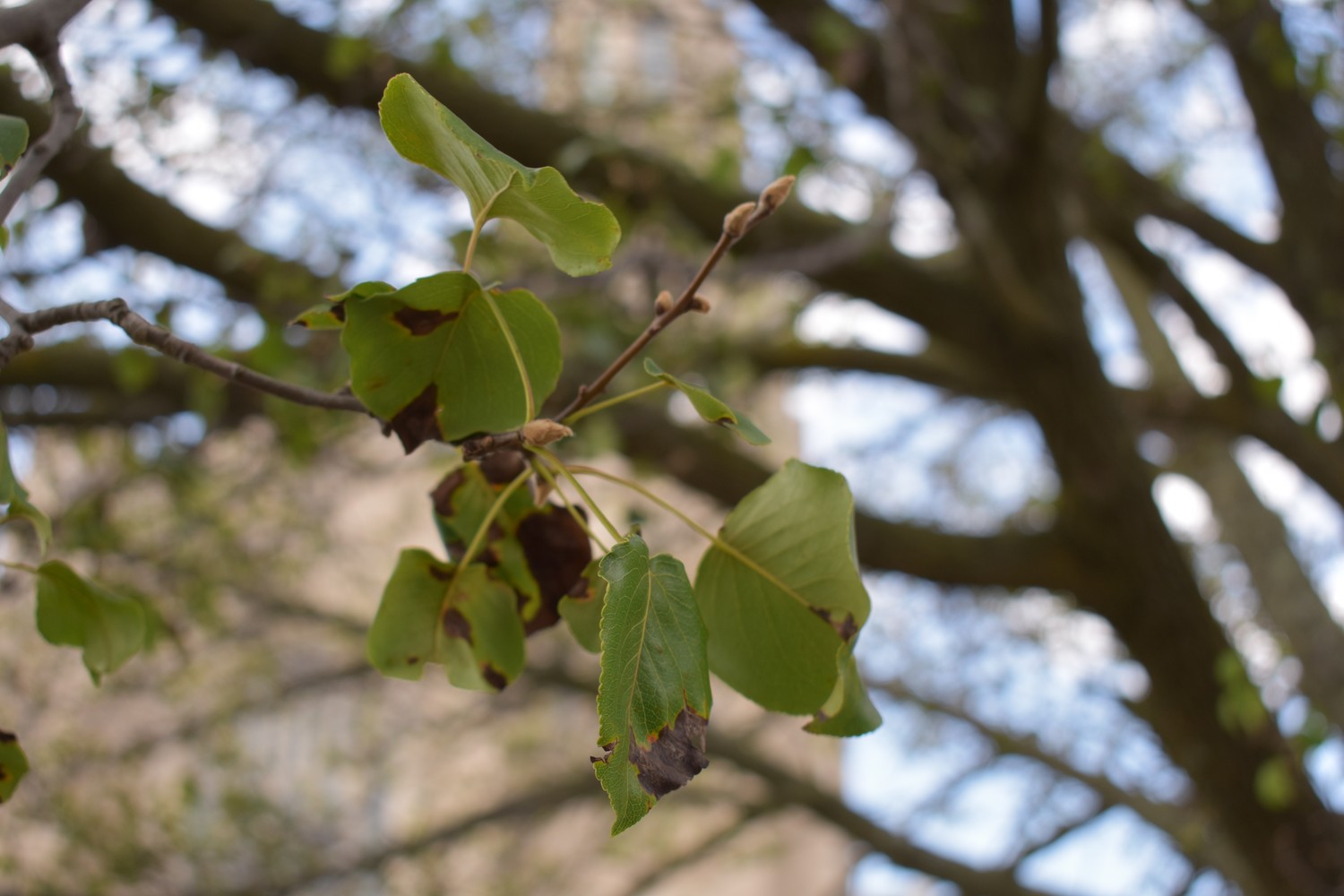Mass removal of Rockville Centre's dying pear trees is imminent
RVC Conservancy leads charge to rid curbsides of diseased ornamentals
More than 100 Rockville Centre residents are considering removing dying pear trees on the curbsides outside of their homes in the coming weeks as part of a “tackling trees” initiative set up by the RVC Conservancy this past summer.
Trellis rust — caused by a fungus new to North America — has spread throughout the village in recent years, leaving many of its ornamental pear trees partially or fully bare, or with discolored or blotchy leaves.
A resident-funded mass removal and replanting of the diseased trees in residential areas was arranged in order to reduce the cost for those wanting to rid them from their properties. The RVC Conservancy, whose initiatives have focused on beautifying the village, received 112 responses from residents, accounting for about 190 trees throughout the village, according to Matt Cliszis, a member of the group.
“We have been working over the past few weeks to provide you with some options that we hope will benefit you and your desire to have healthy curbside trees on your property,” the Conservancy wrote in an email sent to residents last week.
“After consulting with numerous experts … it is our opinion that the best option is to remove and replace Bradford Pear trees,” the email continued. “Their life expectancy is [about] 25 years and many of them are approaching that in the near term. The fungus that impacts them is airborne and is causing problems Island-wide so even if the trees are sprayed and leaf-out one additional year, the chances of this issue being eradicated are slim.”
Cliszis said the Conservancy gathered several cost estimates for tree removals, and plan to use Weeping Willow Tree Service in Oceanside, who have agreed to remove the trees — and grind the stump down two feet to allow for replanting — at a cost of $140 per tree. A plan for replanting next year is still in the works.
Village code requires residents to get approval before removing trees. Spokeswoman Julie Scully said the village is waiting to receive a list from the RVC Conservancy, so that the trees can be inspected for disease. After granted permission to remove the trees, those wishing to replant can order a pre-approved tree from the village, Scully added, or else must get a tree bought elsewhere approved.
“Unfortunately, if they are diseased, they should come down so they don’t infect more trees,” Scully said. “It’s not an ideal situation — we are a green space, we’re a Tree City — but we have to do what’s best too. We don’t want to get other trees infected.” She added that the village is still seeking ways to address the dying trees in Rockville Centre’s downtown, as funds to address the problem are not currently allocated in the budget.
Pear trees have faced this problem for about a decade, according to Vincent Drzewucki, a subject educator in the horticulture, urban and community forestry department at Cornell University’s Cooperative Extension, but it has gotten worse. It affects parts of Suffolk County as well as New York City, but is most prevalent, he added, in Nassau County’s downtown areas.
“We had so many good years where they were absolutely stunning,” said Rockville Centre resident William Picchioni, who recently removed six diseased pear trees from his property. “In May, they would look like a snow canopy over the street and then in the fall they’d have this really bright cranberry-colored leaf. Gorgeous.”
In the midst of the blight, municipalities have begun to address concerns about preserving trees. The Flower Hill village board of trustees passed a local law last month that residents who remove trees from their properties must replace it within a year, Newsday reported last month.
“The homeowner is not required at this time to replant,” Scully said. “It is something that the village will internally discuss.”
Drzewucki said he recommended for residents to plant different kinds of trees to avoid the “disaster” that is taking place with pear trees now.
“No tree is safe to replant or free of diseases,” Drzewucki said. “At one time, the ornamental pears were considered disease-free. Nature changed that. The trees that are recommended for replacements may have other issues, but certainly mixing or diversifying the population of trees helps kind of prevent a major loss.”
Robert Schenone, owner of GB Schenone Nursery in Rockville Centre, said that the disease can be a tough one to tackle by using pesticides, because its spores spread in the wind. “The problem with the spraying, the way I see it, is unless everybody sprays, the disease is still going to be airborne,” he said, adding that spraying — recommended about three times per year in this case — can also be less cost-effective.
He agreed that it’s important to make sure different types of trees are replanted. “You have a species of plants, whether its trees, shrubs, whatever, and you have an area where they’re overplanted,” he said of Rockville Centre. “…When that disease comes into the neighborhood, it goes rampant, because it’s got all this food in front of it and it’s going to jump … from plant to plant.”
Schenone noted that though pear trees are no longer being sold in his nursery or many others, once the disease or insect’s supply source is gone, it leaves the area, and eventually — perhaps years later — they will once again be safe to plant.
“We create the situation, the cycle goes on, and we’re going to pay the price,” Schenone said. “It’s almost part of life.”

 39.0°,
Fair
39.0°,
Fair 




